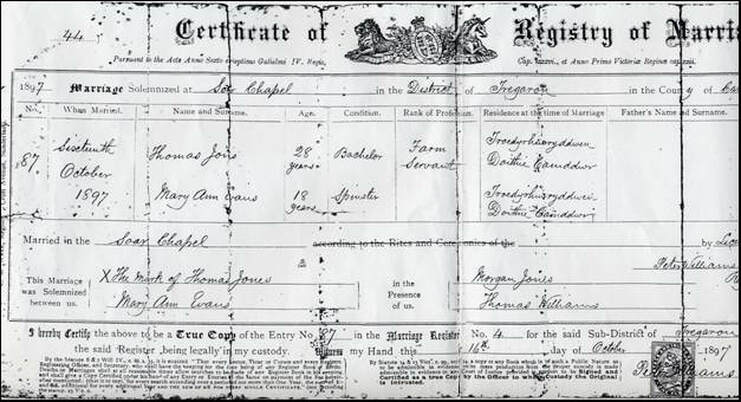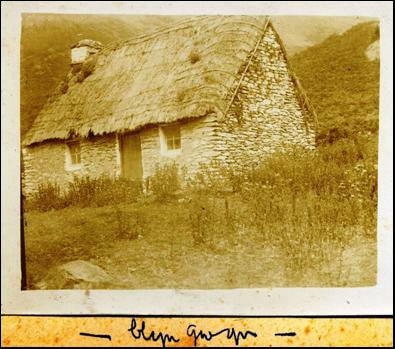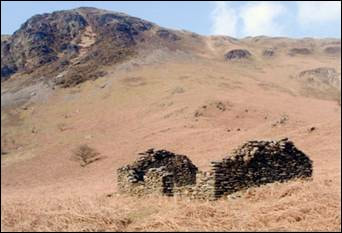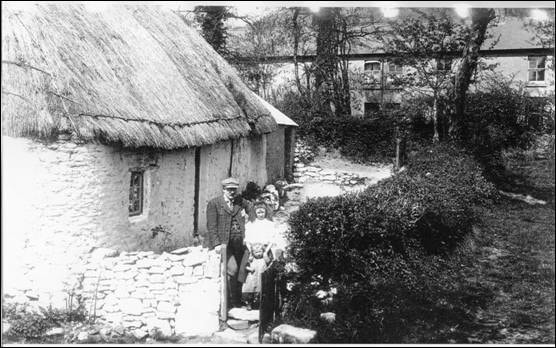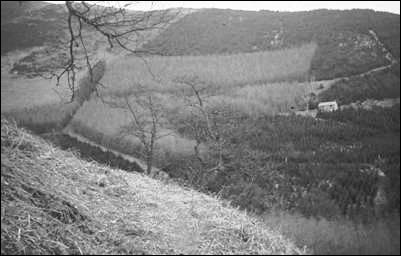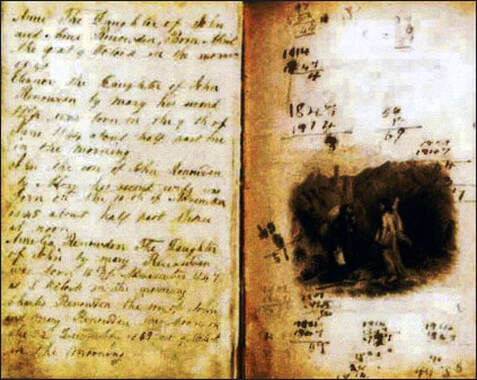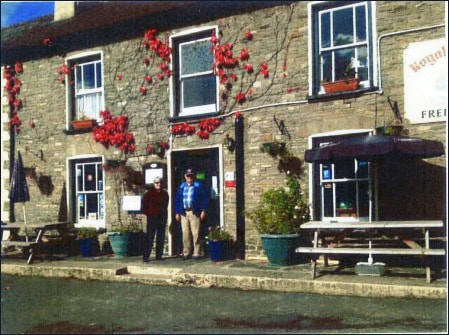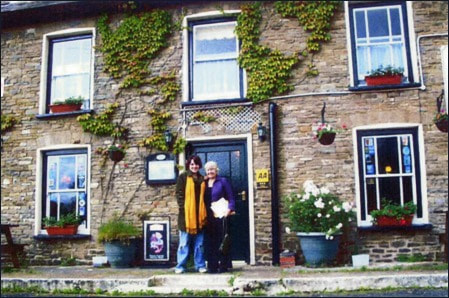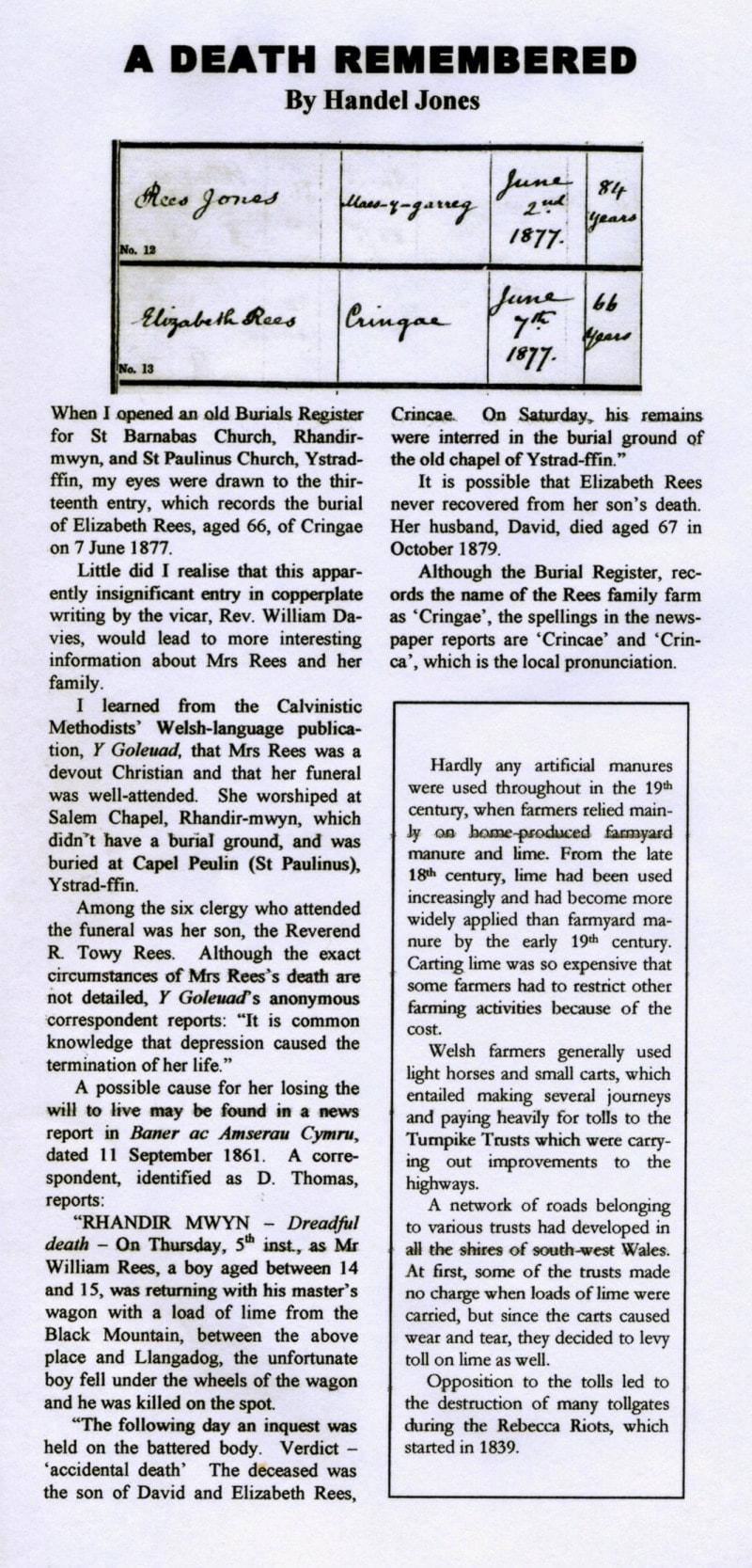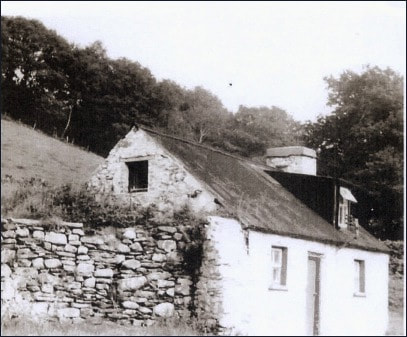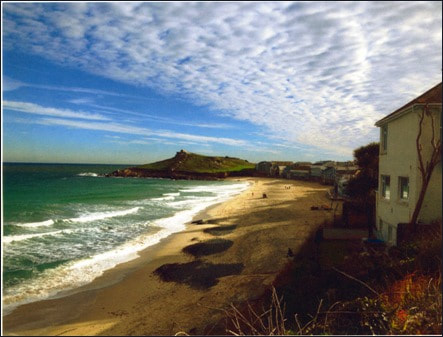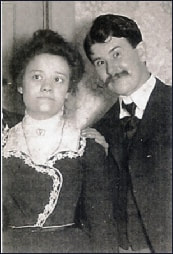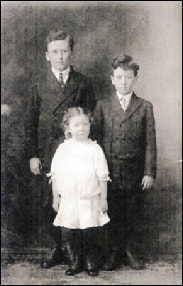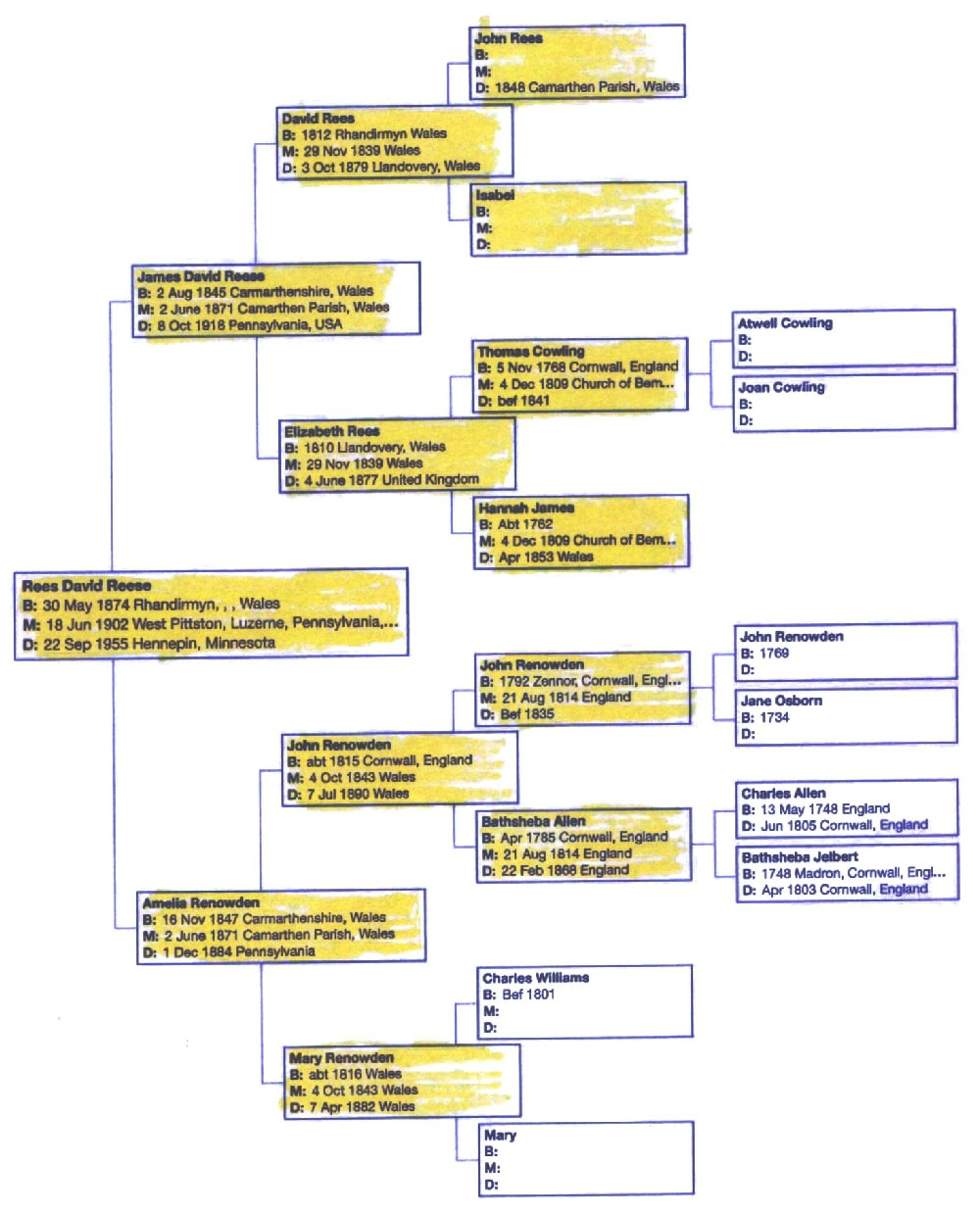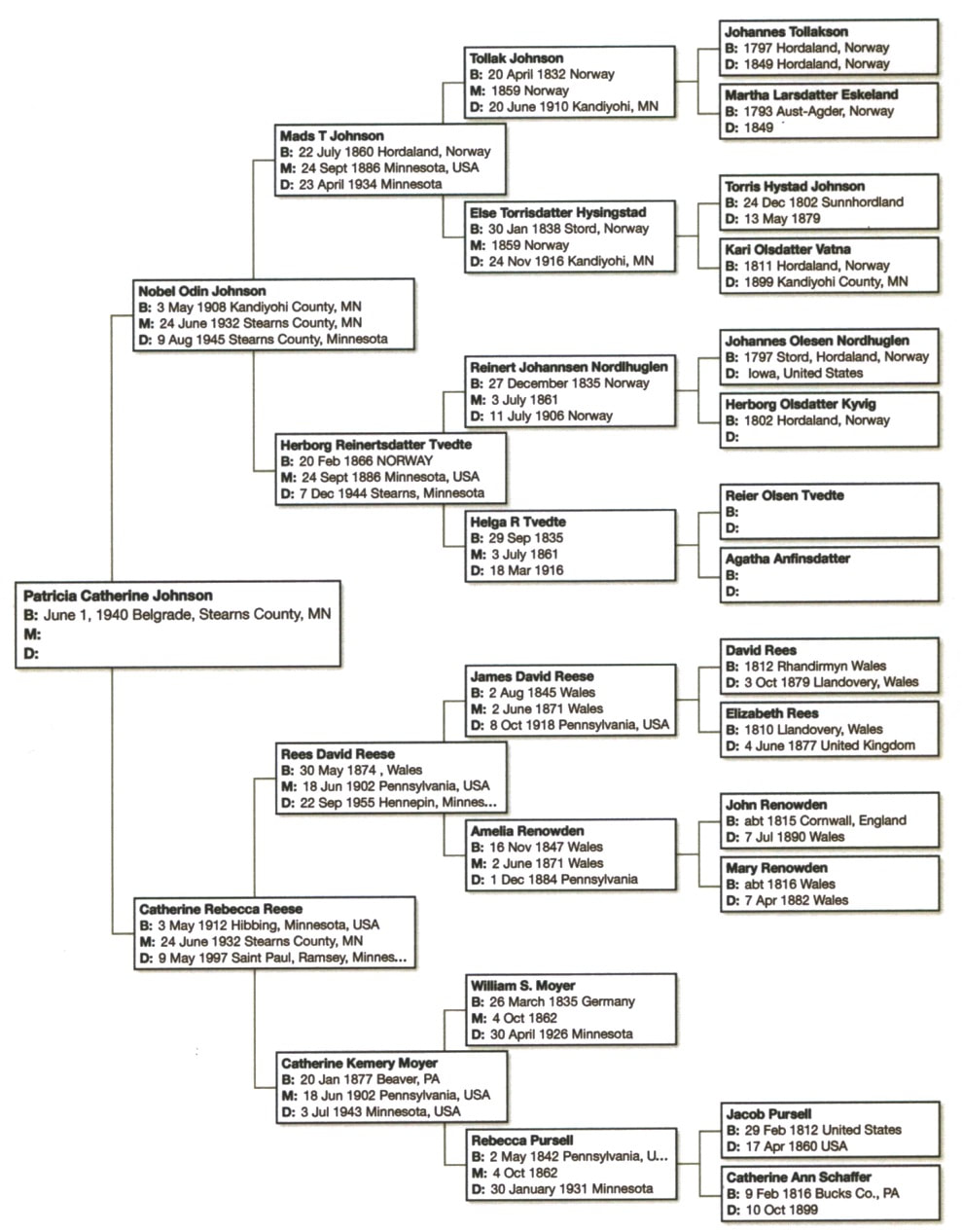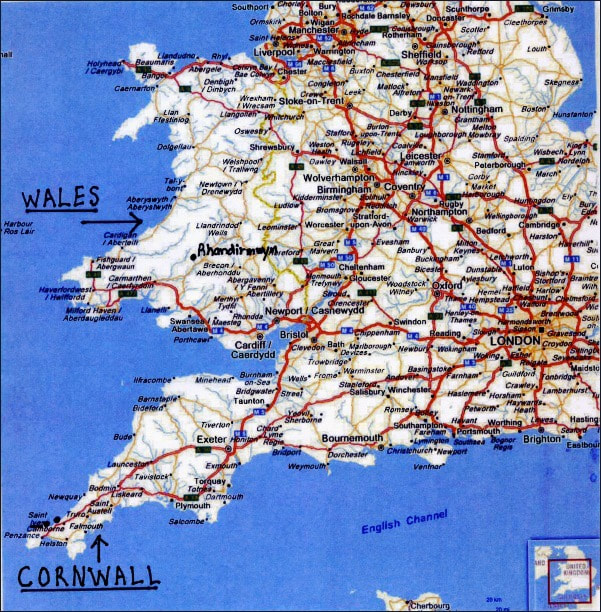Genealogy
If your family history has connections with the Rhandirmwyn area, you are invited to include your family tree or make a résumé of your family history, or both, on this website.
Hopefully, you will take full advantage of this facility as well as the message page where details can be exchanged.
There are few rules to follow other than details of any living person cannot be included and it is suggested that you do not include dates of birth of recently deceased relatives.
If you are researching your family history, please pass on details and hopefully we will be able to assist you with the tracing of relatives, addresses and photographs. Again you are reminded to make full use of the message page to exchange views, information etc.
I am including the history of the Evans family of Gwernhirion, Rhandirmwyn. This was a large family and we are very grateful to Helen Evans for carrying out the huge task of researching and compiling the family tree. A small portion of it is on display.
Alun Jones
Hopefully, you will take full advantage of this facility as well as the message page where details can be exchanged.
There are few rules to follow other than details of any living person cannot be included and it is suggested that you do not include dates of birth of recently deceased relatives.
If you are researching your family history, please pass on details and hopefully we will be able to assist you with the tracing of relatives, addresses and photographs. Again you are reminded to make full use of the message page to exchange views, information etc.
I am including the history of the Evans family of Gwernhirion, Rhandirmwyn. This was a large family and we are very grateful to Helen Evans for carrying out the huge task of researching and compiling the family tree. A small portion of it is on display.
Alun Jones
Evans Family
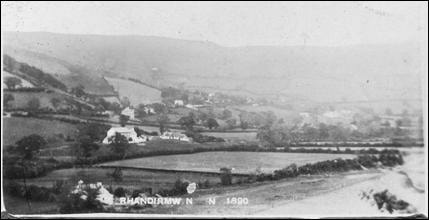
My Paternal Family History By Alun Jones
My grandfather Thomas Jones was born on the 9th March 1868 at Troedrhiwhir Farm, Cwm Gwenffrwd, Rhandirmwyn, the illegitimate son of Elizabeth Jones. I have no other information about her other than I believe she was from the Pontarddulais area. There is no information as to their whereabouts after this time until 1897.
My grandmother Mary Ann Evans however has her roots firmly embedded in Rhandirmwyn. Her family lived in a small cottage called Gwernhirion, which was situated, on the bank of the river Tywi below Salem chapel.
It seems ironic but as a child, I spent many hours climbing the walls of the old cottage without realising its importance in my family history. Today it has totally disappeared having sadly been bulldozed to extend agricultural land. Luckily, Tom Lewis, Bryntowy took a photograph of Salem chapel and in the foreground was Gwernhirion. This may well be the only photograph in existence.
Gwernhirion is the small cottage in the foreground. (next to name Rhandirmwyn).
The photograph is dated 1890 and at this time my family were still living there. Behind is Salem chapel along with some other buildings which have since disappeared.
The census reports of the time give the following details as to the occupiers of Gwernhirion.
1861 Census.
Daniel Evans - 32 years old-head of family - Lead Miner. (my great great grandfather).
Mary Evans - 28 years old-wife. (my great great grandmother)
Evan Evans - 8 years old-son-scholar.
Elizabeth Evans - 6 years old-daughter-scholar.
Ruth Evans - 3 years old-daughter.
Sarah Evans -1 year old. (great grandmother).
1871 Census.
Daniel Evans - 43 years old-head of family-Lead Miner.
Mary Evans - 40 years old-wife.
Evan Evans -19 years old-son-Lead Miner.
Sarah Evans -12 years old-daughter-scholar. (Sarah was my great grandmother).
John Evans - 9 years old-son-scholar. (Later emigrated to America)
Thomas Evans - 7 years old-son-scholar. (Later emigrated to America)
Mary Ann Evans - 5 years old-daughter-scholar. (Died before 1881)
1881 Census.
Daniel Evans - head of family - 54 years old-Lead Miner.
Mary Evans - wife - 50 years old.
Sarah Evans - daughter - 22 years old-dressmaker. (Emigrated to America but returned
John Evans - son - 19 years old - Lead Miner. (Later emigrated to America)
Thomas (D) Evans - son - 17 years old - Lead Miner. (Thomas later emigrated to and settled in Wilkes-Barre, Pennsylvania,U S A. He never returned to Wales and I found his grave along with his wife and child in Mount Greenwood Cemetery, Trucksville, Pennsylvania).
Mary Ann Jones Evans - grand daughter-3 months old. (My grandmother). She was the daughter of Sarah, born out of wedlock. (The fact that the surname Jones is included on her birth certificate may indicate the true father’s surname. who knows).
1891 Census.
Mary Evans - head of family – widow - 63 years old - living on her own means.
Mary Ann Jones Evans - grand daughter-10 years old - scholar. (My grandmother).
By this time John Evans and Thomas (D) Evans were living in America along with my great grandmother Sarah. It is believed however that she later returned to Rhandirmwyn.
As you will see my family history was very closely associated with lead mining in particular the Nantymwyn Lead Mine, Rhandirmwyn.
1901 Census.
Gwernhirion – unoccupied.
The next part of my family history page is dedicated to my paternal grand parents, namely Thomas Jones and Mary Ann Jones Evans. They were married at Soar-y-mynydd, chapel, Cwm Camddwr, Ceredigion on the sixteenth of October 1897. Thomas was 28 years old whilst his bride was only 18. Both were living at this time at Troedrhiwryddwen Farm, Doethie valley, Rhandirmwyn with the Jones family who were probably the most well known and respected families in the region. The marriage certificate indicates that Thomas was employed as a farm servant.
My grandfather Thomas Jones was born on the 9th March 1868 at Troedrhiwhir Farm, Cwm Gwenffrwd, Rhandirmwyn, the illegitimate son of Elizabeth Jones. I have no other information about her other than I believe she was from the Pontarddulais area. There is no information as to their whereabouts after this time until 1897.
My grandmother Mary Ann Evans however has her roots firmly embedded in Rhandirmwyn. Her family lived in a small cottage called Gwernhirion, which was situated, on the bank of the river Tywi below Salem chapel.
It seems ironic but as a child, I spent many hours climbing the walls of the old cottage without realising its importance in my family history. Today it has totally disappeared having sadly been bulldozed to extend agricultural land. Luckily, Tom Lewis, Bryntowy took a photograph of Salem chapel and in the foreground was Gwernhirion. This may well be the only photograph in existence.
Gwernhirion is the small cottage in the foreground. (next to name Rhandirmwyn).
The photograph is dated 1890 and at this time my family were still living there. Behind is Salem chapel along with some other buildings which have since disappeared.
The census reports of the time give the following details as to the occupiers of Gwernhirion.
1861 Census.
Daniel Evans - 32 years old-head of family - Lead Miner. (my great great grandfather).
Mary Evans - 28 years old-wife. (my great great grandmother)
Evan Evans - 8 years old-son-scholar.
Elizabeth Evans - 6 years old-daughter-scholar.
Ruth Evans - 3 years old-daughter.
Sarah Evans -1 year old. (great grandmother).
1871 Census.
Daniel Evans - 43 years old-head of family-Lead Miner.
Mary Evans - 40 years old-wife.
Evan Evans -19 years old-son-Lead Miner.
Sarah Evans -12 years old-daughter-scholar. (Sarah was my great grandmother).
John Evans - 9 years old-son-scholar. (Later emigrated to America)
Thomas Evans - 7 years old-son-scholar. (Later emigrated to America)
Mary Ann Evans - 5 years old-daughter-scholar. (Died before 1881)
1881 Census.
Daniel Evans - head of family - 54 years old-Lead Miner.
Mary Evans - wife - 50 years old.
Sarah Evans - daughter - 22 years old-dressmaker. (Emigrated to America but returned
John Evans - son - 19 years old - Lead Miner. (Later emigrated to America)
Thomas (D) Evans - son - 17 years old - Lead Miner. (Thomas later emigrated to and settled in Wilkes-Barre, Pennsylvania,U S A. He never returned to Wales and I found his grave along with his wife and child in Mount Greenwood Cemetery, Trucksville, Pennsylvania).
Mary Ann Jones Evans - grand daughter-3 months old. (My grandmother). She was the daughter of Sarah, born out of wedlock. (The fact that the surname Jones is included on her birth certificate may indicate the true father’s surname. who knows).
1891 Census.
Mary Evans - head of family – widow - 63 years old - living on her own means.
Mary Ann Jones Evans - grand daughter-10 years old - scholar. (My grandmother).
By this time John Evans and Thomas (D) Evans were living in America along with my great grandmother Sarah. It is believed however that she later returned to Rhandirmwyn.
As you will see my family history was very closely associated with lead mining in particular the Nantymwyn Lead Mine, Rhandirmwyn.
1901 Census.
Gwernhirion – unoccupied.
The next part of my family history page is dedicated to my paternal grand parents, namely Thomas Jones and Mary Ann Jones Evans. They were married at Soar-y-mynydd, chapel, Cwm Camddwr, Ceredigion on the sixteenth of October 1897. Thomas was 28 years old whilst his bride was only 18. Both were living at this time at Troedrhiwryddwen Farm, Doethie valley, Rhandirmwyn with the Jones family who were probably the most well known and respected families in the region. The marriage certificate indicates that Thomas was employed as a farm servant.
Once married they lived in a small cottage called Clyngwyn, which was located next to the Cerrig Tywi falls, Doethie valley, in fact on Troedrhiryddwen farm land. It is a beautiful location but was probably a quite inhospitable place to live especially in winter.
Clyngwyn was a thatch cottage located on a hillside overlooking the junctions of the Tywi and Doethie rivers. Today (2010) the only remains are its walls.
Clyngwyn was a thatch cottage located on a hillside overlooking the junctions of the Tywi and Doethie rivers. Today (2010) the only remains are its walls.
1901 Census
Clyngwyn (Doethie Camddwr).
Thomas Jones – head - 31 years old-worker.
Mary Ann Jones – wife - 21 years old.
Lizzie Mary Jones – daughter - 2 years old.
Sarah Ann Jones-daughter - 9 months.
Thomas was employed as a shepherd on Troedrhiwruddwen Farm.
In 1911 I could trace them to Pentwyn, Rhandirmwyn. This was a small thatch cottage located near St Barnabas church. My father, their youngest sibling David Evan Jones was born there in 1911. At this time the family were as follows.
Thomas Jones-head.
Mary Ann Jones - wife.
Lizzie Mary Jones - daughter. (born Clyngwyn)
Sarah Ann Jones - daughter. (born Clyngwyn)
Rees Tom Jones - son - born 1903. (born Clyngwyn)
Johnny Dan Jones - son - born 1909. (born Pentwyn)
David Evan Jones - son - born 1911. (born Pentwyn)
Clyngwyn (Doethie Camddwr).
Thomas Jones – head - 31 years old-worker.
Mary Ann Jones – wife - 21 years old.
Lizzie Mary Jones – daughter - 2 years old.
Sarah Ann Jones-daughter - 9 months.
Thomas was employed as a shepherd on Troedrhiwruddwen Farm.
In 1911 I could trace them to Pentwyn, Rhandirmwyn. This was a small thatch cottage located near St Barnabas church. My father, their youngest sibling David Evan Jones was born there in 1911. At this time the family were as follows.
Thomas Jones-head.
Mary Ann Jones - wife.
Lizzie Mary Jones - daughter. (born Clyngwyn)
Sarah Ann Jones - daughter. (born Clyngwyn)
Rees Tom Jones - son - born 1903. (born Clyngwyn)
Johnny Dan Jones - son - born 1909. (born Pentwyn)
David Evan Jones - son - born 1911. (born Pentwyn)
Pentwyn cottage, Rhandirmwyn, home of Thomas Jones and family in 1911. (Nantymwyn Terrace in the background).
Their stay in Pentwyn was not long, as by 1917 they had moved to Graig-y-rhaeadr, Cwm rhaeadr, Cilycwm.
Graig-y-rhaeadr, Cwm Rhaeadr, Cilycwm
Their stay in Pentwyn was not long, as by 1917 they had moved to Graig-y-rhaeadr, Cwm rhaeadr, Cilycwm.
Graig-y-rhaeadr, Cwm Rhaeadr, Cilycwm
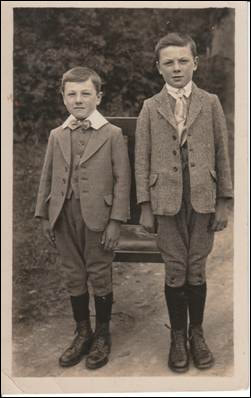
Thomas Jones, was now employed as a shepherd on Mallaen Mountain and it would seem that the house came with the job. His employers were local farmers who co-opted together to pay his wages. His resposibilities extended across the whole mountain from Cilycwm to Rhandirmwyn and north to Cwrt-y-cadno a vast expanse of mountain. In summer it must have been wonderful but winter must have been difficult, although most flocks would have been brought down to lower ground during that period.
By this time the older children had probably started to work. Lizzie Mary worked as a maid at Troedrhiryddwen farm and also at the lead mine offices in Nantymwyn house.
However Johnny Dan and David Evan, my father, attended Cilycwm school, walking each day from their home at the side of the Mallaen Mountain, quite a walk for young boys. I have no doubt however that they could take care of themselves. There is an entry in the book called, ‘Cilycwm, The story of a village school’, by Sara Fox where Dorrie Theophilus recalls the boys and describes them as a, ‘rough lot’. I think my father would probably have smiled at that comment.
For the rest of his life my father was known as,’Dai Graig’, and his brother Johnny Dan was known as, ‘Jack y Graig’.
Later, probably mid 1920’s Thomas Jones ended his association with shepherding and moved back along with his family to live in Rhandirmwyn in fact to number 2 Pannau Street and he took up employment as a labourer at the Nantymwyn Lead Mine thereby continuing the long family association with mining. My father David Evan worked on farms in the area, which included Dolfallt Fawr and Troedrhiwryddwen. However in 1930 he also was employed in the lead mine. This was short lived as on the 16th June 1930 he was working underground alongside William Evans, Cwmsaethau Farm, Rhandirmwyn. There was a fall of rock and a very large piece of rock fell onto William Evans. It would seem that he managed to lift
By this time the older children had probably started to work. Lizzie Mary worked as a maid at Troedrhiryddwen farm and also at the lead mine offices in Nantymwyn house.
However Johnny Dan and David Evan, my father, attended Cilycwm school, walking each day from their home at the side of the Mallaen Mountain, quite a walk for young boys. I have no doubt however that they could take care of themselves. There is an entry in the book called, ‘Cilycwm, The story of a village school’, by Sara Fox where Dorrie Theophilus recalls the boys and describes them as a, ‘rough lot’. I think my father would probably have smiled at that comment.
For the rest of his life my father was known as,’Dai Graig’, and his brother Johnny Dan was known as, ‘Jack y Graig’.
Later, probably mid 1920’s Thomas Jones ended his association with shepherding and moved back along with his family to live in Rhandirmwyn in fact to number 2 Pannau Street and he took up employment as a labourer at the Nantymwyn Lead Mine thereby continuing the long family association with mining. My father David Evan worked on farms in the area, which included Dolfallt Fawr and Troedrhiwryddwen. However in 1930 he also was employed in the lead mine. This was short lived as on the 16th June 1930 he was working underground alongside William Evans, Cwmsaethau Farm, Rhandirmwyn. There was a fall of rock and a very large piece of rock fell onto William Evans. It would seem that he managed to lift
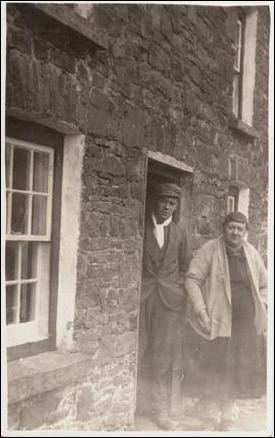 (Photo Mary Ann with Johnny Dan outside their home 2 Pannau Street, Rhandirmwyn).
(Photo Mary Ann with Johnny Dan outside their home 2 Pannau Street, Rhandirmwyn).
the large rock off William’s body but sadly, he was already dead. William Evans was 46 years old. My father was 19 years old but that day was also his last in that mine. He never returned and always described the place as hell on earth. In fact I never heard any of the local people refer to the mine with any affection. William Evans, was buried at Seion chapel, Rhandirmwyn. His gravestone bears the inscription in Welsh, ‘Cyfarfyddodd a damwain angheuol’, which literally translated says, ‘met with a fatal accident’.
On the 28th of August 1933 Mary Anne, my grandmother, died at her home, 2 Pannau Street, Rhandirmwyn. She was 55 years old. She was buried at St Barnabas church, Rhandirmwyn.
Thomas Jones continued to reside there until his death on 24th April 1940 at the age of 72 years. He is also buried at St Barnabas church, Rhandirmwyn.
By this time, my father David Evan Jones had met and married my mother Mary Ann. She was from, Pencaedu Farm, Cwmgors, Glamorgan and had moved to the area as a young girl of 14 to work in the Royal Oak public house as a maid. The landlord was William Renowden. His wife Sara (nee Griffiths) was also from Cwmgors. My parents were married in 1935 and of the marriage there were three children all boys. For a time my parents lived at 4 Pannau Street but eventually moved to Nantymwyn Terrace, (Wyrddol), Rhandirmwyn where they spent the rest of their days.
During the war David Evan worked for the ministry of supply, mainly felling trees on large estates in the Tywi valley. The timber, was then used in the war effort.
I recollect a story of the time when he and Roderick Walters (Rhandirmwyn) were felling trees on the Golden Grove estate, Llandeilo. Both were without doubt of the highest order of salmon poachers. They were returning home one evening on a motor cycle when the estate gamekeeper stopped them and pointed out that someone was poaching a large number of salmon from the river that ran through the estate. He asked if they would keep a look out and inform him if they saw anyone suspicious. Both agreed to assist without question and probably told him of their abhorrence of such activity. They then roared off towards home. At the time Rod had a 20 pound salmons strapped around his waist.
David Evan had been turned down for the military duty as he had been accidentally shot with a shotgun shortly before the war started and this had affected his hearing. (Shortly before his death an x-rayed revealed a large number of pellets still embedded in his body, one right next to his heart. If that had punctured his heart then I would not be here to tell this tale as it happened many years before I was born).
He was a true countryman and rarely left his, ‘filltir sgwar’, square mile. His life revolved around his family and his beloved Rhandirmwyn. His main pleasure was to go fishing and over the years he must have caught hundreds of prime Tywi salmon. Many were given away to friends and neighbours.
Since about 1950 along with many of the village men he worked for the Forestry Commission initially as a trapper and then as a labourer in the Caio and Tywi Forests.
Many people, including me have complained about the large tree plantations that cover our mountains in the upper Tywi valley. It must be remembered however that without the work provided by the commission, then many families would have left the valley for good as happened with my generation. So, in that respect I am very grateful.
In the mid 1970’s the Forestry Commission were reducing their staff numbers as the work had been completed and now there was the long wait for the trees to mature and grow. (A large tree felling, programme has been ongoing throughout 2005 until the present day so the fruits of their labour has been realised. Sadly, most of the men are no longer with us).
After ending his association with the Forestry Commission he went to work on the Llyn Brianne reservoir scheme as a watchman. I recollect him saying it was easy money compared to his arduous years climbing the hillsides planting trees.
David Evan died in 1978 at the age of 66 years. Mary Ann, my mother, died in January 2005 at the age of 92. She had live in Rhandirmwyn for 78 years but always maintained that she was never, accepted as a, ‘local’, always an outsider. You have to be born here to be recognised as a ‘local’.
Lizzie Mary eventually moved to Swansea and had 5 children. She died in 1972.
Sarah Ann lived for long periods in London but eventually settled in Llandovery. She had one daughter and died in Llandeilo in 1988.
Rees Tom Jones settled in Gwynfe, Carmarthenshire (Ynystoddeb Farm). He had one daughter. He died in 1971 At the age of 68 years.
Johnny Dan settled near Chester and had 8 children. He died in 1975 aged 66 years.
There are many descendants of Thomas and Mary Ann Jones. From that little cottage, on the hillside in the Doethie valley the family now extends from, Wales to England, Dubai, Italy and yes once more, America.
Alun Jones
On the 28th of August 1933 Mary Anne, my grandmother, died at her home, 2 Pannau Street, Rhandirmwyn. She was 55 years old. She was buried at St Barnabas church, Rhandirmwyn.
Thomas Jones continued to reside there until his death on 24th April 1940 at the age of 72 years. He is also buried at St Barnabas church, Rhandirmwyn.
By this time, my father David Evan Jones had met and married my mother Mary Ann. She was from, Pencaedu Farm, Cwmgors, Glamorgan and had moved to the area as a young girl of 14 to work in the Royal Oak public house as a maid. The landlord was William Renowden. His wife Sara (nee Griffiths) was also from Cwmgors. My parents were married in 1935 and of the marriage there were three children all boys. For a time my parents lived at 4 Pannau Street but eventually moved to Nantymwyn Terrace, (Wyrddol), Rhandirmwyn where they spent the rest of their days.
During the war David Evan worked for the ministry of supply, mainly felling trees on large estates in the Tywi valley. The timber, was then used in the war effort.
I recollect a story of the time when he and Roderick Walters (Rhandirmwyn) were felling trees on the Golden Grove estate, Llandeilo. Both were without doubt of the highest order of salmon poachers. They were returning home one evening on a motor cycle when the estate gamekeeper stopped them and pointed out that someone was poaching a large number of salmon from the river that ran through the estate. He asked if they would keep a look out and inform him if they saw anyone suspicious. Both agreed to assist without question and probably told him of their abhorrence of such activity. They then roared off towards home. At the time Rod had a 20 pound salmons strapped around his waist.
David Evan had been turned down for the military duty as he had been accidentally shot with a shotgun shortly before the war started and this had affected his hearing. (Shortly before his death an x-rayed revealed a large number of pellets still embedded in his body, one right next to his heart. If that had punctured his heart then I would not be here to tell this tale as it happened many years before I was born).
He was a true countryman and rarely left his, ‘filltir sgwar’, square mile. His life revolved around his family and his beloved Rhandirmwyn. His main pleasure was to go fishing and over the years he must have caught hundreds of prime Tywi salmon. Many were given away to friends and neighbours.
Since about 1950 along with many of the village men he worked for the Forestry Commission initially as a trapper and then as a labourer in the Caio and Tywi Forests.
Many people, including me have complained about the large tree plantations that cover our mountains in the upper Tywi valley. It must be remembered however that without the work provided by the commission, then many families would have left the valley for good as happened with my generation. So, in that respect I am very grateful.
In the mid 1970’s the Forestry Commission were reducing their staff numbers as the work had been completed and now there was the long wait for the trees to mature and grow. (A large tree felling, programme has been ongoing throughout 2005 until the present day so the fruits of their labour has been realised. Sadly, most of the men are no longer with us).
After ending his association with the Forestry Commission he went to work on the Llyn Brianne reservoir scheme as a watchman. I recollect him saying it was easy money compared to his arduous years climbing the hillsides planting trees.
David Evan died in 1978 at the age of 66 years. Mary Ann, my mother, died in January 2005 at the age of 92. She had live in Rhandirmwyn for 78 years but always maintained that she was never, accepted as a, ‘local’, always an outsider. You have to be born here to be recognised as a ‘local’.
Lizzie Mary eventually moved to Swansea and had 5 children. She died in 1972.
Sarah Ann lived for long periods in London but eventually settled in Llandovery. She had one daughter and died in Llandeilo in 1988.
Rees Tom Jones settled in Gwynfe, Carmarthenshire (Ynystoddeb Farm). He had one daughter. He died in 1971 At the age of 68 years.
Johnny Dan settled near Chester and had 8 children. He died in 1975 aged 66 years.
There are many descendants of Thomas and Mary Ann Jones. From that little cottage, on the hillside in the Doethie valley the family now extends from, Wales to England, Dubai, Italy and yes once more, America.
Alun Jones
Renowden & Rees
Renowden and Rees Family of Rhandirmwyn
This is a very personal story by Pat Schumacher accounting her search for her family roots. Pat lives in Florida, USA but Rhandirmwyn has become virtually her second home as much of her family history and memories are embedded in these beautiful hills. Her ancestors emigrated to America in 1882, sailing from Liverpool. The journey started in tragic circumstances as one of their children was burnt to death in Liverpool shortly before embarking on the arduous journey across the Atlantic.
Thank you Pat for sharing the information and story.
I must also add a note of gratitude to the Renowden family as my late mother moved to Rhandirmwyn in 1927 at the age of 14 from the Swansea valley to work for William and Sarah Renowden at the Royal Oak public house. I have no doubt that it was there she met my father who had been born in the village. The rest is history.
Alun Jones
Renowden and Rees: An Introductions
My research into the Welsh branch of the family brought many surprises: for one, the ancestors were as much Cornish as Welsh in heritage. The Cornish people moved back and forth, by sea, between the very southwestern-most part of England to Wales for work in the mines. Their mining skills were highly sought after in times when Wales needed more skilled workers. Marriage was common among the Welsh and Cornish families and, as it turns out, we are as much Cornish as Welsh.
That said, the connection between the Cornish people and the Welsh people is stronger than geography. They are both of Celtic origin, and both were pushed back when the Normans invaded England. Their native languages are similar in origin.
Rhandirmwyn, the birthplace of my grandfather, Rees Reese, is a small village nestled in the Cambrian Mountains. Lead mining has been the major employer in the village for centuries, some say back to Roman times (400 A.D.). Initially, it was part of a fiefdom owned by the British Lord Cawdor. The countryside has an ancient history, some say going back to Merlin who, it is said, lived in a cave in the mountains nearby.
The Reese name is of Welsh origin, originally spelled Rhys, then Rees, then Reese. In feudal times, there were famous warriors named Rhys. Tracing family from the ancient times to the present, with a very common Welsh name, proved impossible. I was only able to find definite family links going back to the late 1700’s. Using the same first and last names is a common practice, hence my grandfather’s name, Rees David Reese. His first name uses the older form, while the surname changed permanently to add an “e” to the end, when the family immigrated to America.
Renowdens were an interesting study. They came to Wales from Cornwall and go back much further, to the early 1700’s in England. The have migrated to Australia as well as America. There are fewer Renowdens left in England now, and none in Wales that I found.
NOTES ON RESEARCH AND TRAVEL TO WALES AND CORNWALL
I visited Wales three times: the first in 1974, with husband Kay Schumacher. I had in hand a very old picture from my grandfather, of a building that I believed was in Wales. We stayed in a bed and breakfast in Llandovery, Wales, the nearest large town to the village of Rhandirmwyn where my grandfather was born. That evening in the lodge, I passed the picture around to other guests. One man, a salesman, immediately recognized the building as the pub in the middle of Rhandirmwyn, and he said we would have no trouble finding it the next morning.
Rhandirmwyn is about seven miles from Llandovery but the road climbs into the mountains; it is winding and narrow, with hedgerows along the edges. Meeting cars (while on the left side of the road) is formidable. Just as the salesman told us, the pub dominates the village. The Royal Oak Inn is a solid stone building, larger than most other buildings, at the top of a hill and right off the road that winds through town.
We stopped and visited with the owners. They informed us that the last Renowdens to own the pub had left it in 1954, twenty years earlier. I visited with a few people in town and showed the picture around. There are four men in the picture, lounging on the grass in front of the inn. Three were immediately identified but the fourth, the one I determined might be the relative, went unnamed. Last, we visited the home of a Mrs. James (her maiden name was Reese) and she knew the fourth man immediately—it was Johhny Renowden, son of the John Renowden who built the pub in 1846. Johnny hanged himself, she said, in the pub. I’m sure all the others knew that, too, but didn't want to tell the American about the family tragedy.
The second trip was in 2008, thirty-four years later, with granddaughter Seina. All the people I had visited with on the first trip had passed away. We visited the pub and its new owners, Leigh and Claire Alexander, who have owned it for the last twenty-two years. They built an addition as living quarters for their family. They showed us the rooms upstairs which are available for hire. They are small, modest rooms, with bathrooms down the hall. They knew little about the Renowden history and I shared what I knew with them, including the story of Johnny Renowden hanging himself upstairs. They responded with stories of ghosts in the building and specific incidences when a “ghost barman” was taking orders that were never filled.
We visited #4 Pannau Street, the center unit of an eight-unit stone row house, and the birthplace of Grandpa Reese. It had just been purchased by Christine Reilly who was moving in, and offered to let us in to see the interior. Kitchens and a bathroom have been added on to the back of the building; in Grandpa’s day the cooking was done over the fireplace, and the outhouse down the way served all eight families.
The third trip to Wales was in 2012, with brother Bob. The internet has become an important tool in the meantime, and I connected with Alun Jones who created a website for the village of Rhandirmwyn. We met he and his wife, Carol, and were led on a close and personal tour of the village, the closed down mine where our great-grandfather labored, and the surrounding countryside. It was a rich and valuable experience for us both. Alun grew up in Rhandirmwyn and was able to answer many, many questions. He helped us research the Reese family back further, and found a valuable newspaper article on Elizabeth Cowling, a Cornish great-great-grandmother who lived in the village and married a Reese.
From there, we drove to the National Library of Wales in Aberystwyth on the west coast of Wales. We spent two days researching family and were able to discover another couple of generations back. We looked at Bishop’s handwritten copies of church registers that went back to the 1500’s. It is a an amazing resource and I could spend weeks there.
Rick Parsons has done years of genealogical research on the Renowden Family which I also found on the internet. We connected by e-mail and he very kindly shared his extensive work with me. His wife, Mary Parsons, is my third cousin; it is her family who produced the Welsh Bishop. We met for dinner one evening in Bristol.
Last, Bob and I drove to Cornwall and were amazed at the rugged beauty. The tops of the hills are moors which are windswept and grassy, but the terrain going down to the sea is rugged and steep. We visited St. Ives, birthplace of John Renowden, and also visited St. Agnes, the birthplace of Thomas Cowling. Both are villages hugging the shoreline, beneath the rocky hills above them. They are beautiful beyond description.
The interior town of Truro, Cornwall, has a genealogy center which we visited. The volunteers there were very helpful and solved some mysteries I had about lineage, and pushed us back another few generations with the Renowden family.
And now, to introduce my Grandfather Reese, my mother’s father, we journey to Wales, and to Cornwall in Southwest England.
This is a very personal story by Pat Schumacher accounting her search for her family roots. Pat lives in Florida, USA but Rhandirmwyn has become virtually her second home as much of her family history and memories are embedded in these beautiful hills. Her ancestors emigrated to America in 1882, sailing from Liverpool. The journey started in tragic circumstances as one of their children was burnt to death in Liverpool shortly before embarking on the arduous journey across the Atlantic.
Thank you Pat for sharing the information and story.
I must also add a note of gratitude to the Renowden family as my late mother moved to Rhandirmwyn in 1927 at the age of 14 from the Swansea valley to work for William and Sarah Renowden at the Royal Oak public house. I have no doubt that it was there she met my father who had been born in the village. The rest is history.
Alun Jones
Renowden and Rees: An Introductions
My research into the Welsh branch of the family brought many surprises: for one, the ancestors were as much Cornish as Welsh in heritage. The Cornish people moved back and forth, by sea, between the very southwestern-most part of England to Wales for work in the mines. Their mining skills were highly sought after in times when Wales needed more skilled workers. Marriage was common among the Welsh and Cornish families and, as it turns out, we are as much Cornish as Welsh.
That said, the connection between the Cornish people and the Welsh people is stronger than geography. They are both of Celtic origin, and both were pushed back when the Normans invaded England. Their native languages are similar in origin.
Rhandirmwyn, the birthplace of my grandfather, Rees Reese, is a small village nestled in the Cambrian Mountains. Lead mining has been the major employer in the village for centuries, some say back to Roman times (400 A.D.). Initially, it was part of a fiefdom owned by the British Lord Cawdor. The countryside has an ancient history, some say going back to Merlin who, it is said, lived in a cave in the mountains nearby.
The Reese name is of Welsh origin, originally spelled Rhys, then Rees, then Reese. In feudal times, there were famous warriors named Rhys. Tracing family from the ancient times to the present, with a very common Welsh name, proved impossible. I was only able to find definite family links going back to the late 1700’s. Using the same first and last names is a common practice, hence my grandfather’s name, Rees David Reese. His first name uses the older form, while the surname changed permanently to add an “e” to the end, when the family immigrated to America.
Renowdens were an interesting study. They came to Wales from Cornwall and go back much further, to the early 1700’s in England. The have migrated to Australia as well as America. There are fewer Renowdens left in England now, and none in Wales that I found.
NOTES ON RESEARCH AND TRAVEL TO WALES AND CORNWALL
I visited Wales three times: the first in 1974, with husband Kay Schumacher. I had in hand a very old picture from my grandfather, of a building that I believed was in Wales. We stayed in a bed and breakfast in Llandovery, Wales, the nearest large town to the village of Rhandirmwyn where my grandfather was born. That evening in the lodge, I passed the picture around to other guests. One man, a salesman, immediately recognized the building as the pub in the middle of Rhandirmwyn, and he said we would have no trouble finding it the next morning.
Rhandirmwyn is about seven miles from Llandovery but the road climbs into the mountains; it is winding and narrow, with hedgerows along the edges. Meeting cars (while on the left side of the road) is formidable. Just as the salesman told us, the pub dominates the village. The Royal Oak Inn is a solid stone building, larger than most other buildings, at the top of a hill and right off the road that winds through town.
We stopped and visited with the owners. They informed us that the last Renowdens to own the pub had left it in 1954, twenty years earlier. I visited with a few people in town and showed the picture around. There are four men in the picture, lounging on the grass in front of the inn. Three were immediately identified but the fourth, the one I determined might be the relative, went unnamed. Last, we visited the home of a Mrs. James (her maiden name was Reese) and she knew the fourth man immediately—it was Johhny Renowden, son of the John Renowden who built the pub in 1846. Johnny hanged himself, she said, in the pub. I’m sure all the others knew that, too, but didn't want to tell the American about the family tragedy.
The second trip was in 2008, thirty-four years later, with granddaughter Seina. All the people I had visited with on the first trip had passed away. We visited the pub and its new owners, Leigh and Claire Alexander, who have owned it for the last twenty-two years. They built an addition as living quarters for their family. They showed us the rooms upstairs which are available for hire. They are small, modest rooms, with bathrooms down the hall. They knew little about the Renowden history and I shared what I knew with them, including the story of Johnny Renowden hanging himself upstairs. They responded with stories of ghosts in the building and specific incidences when a “ghost barman” was taking orders that were never filled.
We visited #4 Pannau Street, the center unit of an eight-unit stone row house, and the birthplace of Grandpa Reese. It had just been purchased by Christine Reilly who was moving in, and offered to let us in to see the interior. Kitchens and a bathroom have been added on to the back of the building; in Grandpa’s day the cooking was done over the fireplace, and the outhouse down the way served all eight families.
The third trip to Wales was in 2012, with brother Bob. The internet has become an important tool in the meantime, and I connected with Alun Jones who created a website for the village of Rhandirmwyn. We met he and his wife, Carol, and were led on a close and personal tour of the village, the closed down mine where our great-grandfather labored, and the surrounding countryside. It was a rich and valuable experience for us both. Alun grew up in Rhandirmwyn and was able to answer many, many questions. He helped us research the Reese family back further, and found a valuable newspaper article on Elizabeth Cowling, a Cornish great-great-grandmother who lived in the village and married a Reese.
From there, we drove to the National Library of Wales in Aberystwyth on the west coast of Wales. We spent two days researching family and were able to discover another couple of generations back. We looked at Bishop’s handwritten copies of church registers that went back to the 1500’s. It is a an amazing resource and I could spend weeks there.
Rick Parsons has done years of genealogical research on the Renowden Family which I also found on the internet. We connected by e-mail and he very kindly shared his extensive work with me. His wife, Mary Parsons, is my third cousin; it is her family who produced the Welsh Bishop. We met for dinner one evening in Bristol.
Last, Bob and I drove to Cornwall and were amazed at the rugged beauty. The tops of the hills are moors which are windswept and grassy, but the terrain going down to the sea is rugged and steep. We visited St. Ives, birthplace of John Renowden, and also visited St. Agnes, the birthplace of Thomas Cowling. Both are villages hugging the shoreline, beneath the rocky hills above them. They are beautiful beyond description.
The interior town of Truro, Cornwall, has a genealogy center which we visited. The volunteers there were very helpful and solved some mysteries I had about lineage, and pushed us back another few generations with the Renowden family.
And now, to introduce my Grandfather Reese, my mother’s father, we journey to Wales, and to Cornwall in Southwest England.
JOHN RENOWDEN and the ROYAL OAK INN Born 1815 - 7 July 1890
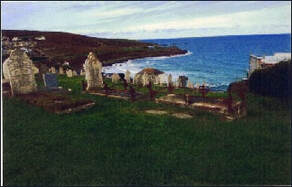
Maternal Great-great grandfather, father of Amelia Renowden Reese, my great-grandmother
The earliest members of the Renowden family came from Cornwall, the southwestern-most part of England, so at least half of the "Welsh" family heritage is actually English. Since Cornwall and Wales were both inhabited by descendants of the ancient Bretons (now called “Celtic”), the original modern settlers in the British Isles, it is safe to say they are all from the same or similar stock. Their native language, both Celtic dialogs, are similar.
John Renowden was born in a tiny sea coast town of St. Ives, Cornwall, in the southwest corner of England, in the year 1815.
His parents were John Renowden of Zennor, Cornwall (1792-1835) and Bathsheba Allen (1785-1868)
As a young man, John migrated to Wales, to work in the Nantymwyn mine in Rhandirmwyn, county of Carmarthen, Wales. He most likely traveled by ship, probably in the late 1830's. Both Cornwall and central Wales were mining areas but the Cornish people had the reputation for more knowledge and experience and were highly sought after as employees when times were good. In 1836, the lease ownership of the mine was transferred to a Cornish family named Williams and it is probable that many Cornish miners migrated to Wales then.
Sometime between 1846 and 1851, John established a public house called the Royal Oak Inn. It had a few rooms to let upstairs, and downstairs the public house served food and drinks. The stone building was heated by two large fireplaces, one at each end of the main room. The Inn was in the Renowden family for over 100 years.
John Renowden married three times, each time to a local area woman. His first wife, Anne Davies, died in childbirth at the age of 21, bearing their third child. Only one child lived, Anne (born 1840), and she apparently was raised by another family after her mother’s death (in 1842).
His second wife (my great-great grandmother) was Mary Williams (1816-1882) from Llansawel, a small town about 12 miles from Rhandirmwyn. Her father was Charles Williams. John and Mary were married October 4, 1843, and had seven children, five boys and two girls. My great-grandmother, Amelia Renowden (1847-1884) was the third-born and the only surviving girl. John Renowden recorded all the children’s births in the front pages of a copy of Pilgrim’s Progress. I received this book after my trip to Wales in 2012, as the last surviving Renowden relative in the area had died without descendants.
The earliest members of the Renowden family came from Cornwall, the southwestern-most part of England, so at least half of the "Welsh" family heritage is actually English. Since Cornwall and Wales were both inhabited by descendants of the ancient Bretons (now called “Celtic”), the original modern settlers in the British Isles, it is safe to say they are all from the same or similar stock. Their native language, both Celtic dialogs, are similar.
John Renowden was born in a tiny sea coast town of St. Ives, Cornwall, in the southwest corner of England, in the year 1815.
His parents were John Renowden of Zennor, Cornwall (1792-1835) and Bathsheba Allen (1785-1868)
As a young man, John migrated to Wales, to work in the Nantymwyn mine in Rhandirmwyn, county of Carmarthen, Wales. He most likely traveled by ship, probably in the late 1830's. Both Cornwall and central Wales were mining areas but the Cornish people had the reputation for more knowledge and experience and were highly sought after as employees when times were good. In 1836, the lease ownership of the mine was transferred to a Cornish family named Williams and it is probable that many Cornish miners migrated to Wales then.
Sometime between 1846 and 1851, John established a public house called the Royal Oak Inn. It had a few rooms to let upstairs, and downstairs the public house served food and drinks. The stone building was heated by two large fireplaces, one at each end of the main room. The Inn was in the Renowden family for over 100 years.
John Renowden married three times, each time to a local area woman. His first wife, Anne Davies, died in childbirth at the age of 21, bearing their third child. Only one child lived, Anne (born 1840), and she apparently was raised by another family after her mother’s death (in 1842).
His second wife (my great-great grandmother) was Mary Williams (1816-1882) from Llansawel, a small town about 12 miles from Rhandirmwyn. Her father was Charles Williams. John and Mary were married October 4, 1843, and had seven children, five boys and two girls. My great-grandmother, Amelia Renowden (1847-1884) was the third-born and the only surviving girl. John Renowden recorded all the children’s births in the front pages of a copy of Pilgrim’s Progress. I received this book after my trip to Wales in 2012, as the last surviving Renowden relative in the area had died without descendants.
THE ROYAL OAK INN, about 1890.
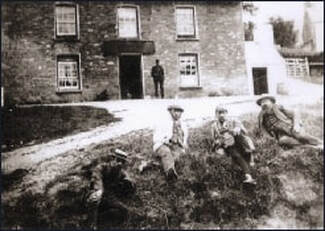
Left to right: David Vincent Lewis (Schoolmaster), Johnny Renowden (Owner of the Royal Oak Inn and eldest son of John Renowden, brother of Amelia), David Owen (Schoolmaster, Postmaster and historian of the Rhandirmwyn area), and David Thomas (neighbor on Pannau Street and owner of the Miner’s Arms pub)
Royal Oak Inn, 2012. Pat Schumacher and Bob Johnson (great-great-grandchildren of John Renowden).
AMELIA RENOWDEN 16 Nov 1847 - 1 Dec 1884
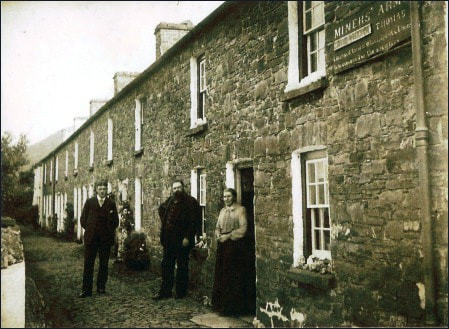 Miners Arms, Pannau Street
Miners Arms, Pannau Street
My Maternal Great-grandmother and mother of my grandfather, Rees Reese. daughter of John Renowden, founder of the Royal Oak Inn.
The short story of Amelia’s life, pieced together with census data, birth and death records and ship manifests, tells a story of a young woman who bore nine children and lost four of them within a two-year period. She died two years after immigrating to America, at age 37, most likely as a result of the birth of her ninth child, who also died.
Amelia was my great-grandmother and was born November 16, 1847, in Rhandirmwyn, Carmarthenshire County, Wales. She was the second of six children, and her parents, John and Mary Renowden, were owners of a new pub (the Royal Oak Inn built about 1846), located in the center of the mining village of Rhandirmwyn. She was the only surviving girl child. Most likely, Amelia had no schooling at all and, in her teen years, worked as a bar maid.
At age 22 she married James David Reese, the son of local farmers just south of town. They had six children in nine years, and lived in a tiny stone row house on Pannau Street, #4. Eight families lived in the row of attached two-room cottages. The housing was provided for the miners to rent, and many of the families had origins in Cornwall.
Winters in the low mountains around Rhandirmwyn could be quite cold, with a raw wind whipping up between the high hills. The house had two windows which had to be stuffed around the edges with paper or cloth in the winters and hung with curtains to keep out the cold. The only heat was from the fireplace. James worked in the nearby mine and was sometimes paid with lumps of coal. The family buried coal in the ground to store it until needed. (Christine Reilly, who bought the stone row house in 2008, found a large lump of coal buried in the garden).
Life in the years from Amelia’s birth in1847, to the time they left for America in 1882, was harsh and hungry. The family had no wealth to own a horse, so any transportation was on foot, or had to be purchased. In the backyard of the row house, families kept gardens and probably a coop of chickens, perhaps a goat for milk. The garden was essential to provide food; there were no grocery stores
Below, Pannau Street about 1890 showing the Thomas family, neighbors of James and Amelia Reese. The Thomas’s ran the Miners’ Arms, a pub, from their two-room home. It was located on the end of the row, next to the path the miners used when they walked home at the end of the day. You can see the sign next to the upstairs window.
James and Amelia lived in Unit #4, in the center of the row. The downstairs was one great room, with a fireplace for cooking and providing warmth to the entire home. All family activities, except sleeping, occurred in this room. Upstairs was one bedroom, where six children and two adults slept. There was probably only one bed. The rooms were small, perhaps 9 by 10 feet. There was no running water and the toilet was outside.
Children were born at home, perhaps with a local woman attending. Amelia gave birth to David in 1871 (she was 24), John in 1872, Rees (my grandfather) in 1874, Daniel in 1875, Mary in 1876, Isaac in 1879, and Elizabeth in 1880.
Amelia had two more babies in America, Bessie, born in 1883, and Charles, still born, in 1984. Also in 1883, a diphtheria epidemic took her second son, John, and baby Isaac.
I can find no record of Amelia after 1884. My assumption is that she died in childbirth, along with Charles. Before she died, Amelia lost four of her nine children. She was 37 years old.
The short story of Amelia’s life, pieced together with census data, birth and death records and ship manifests, tells a story of a young woman who bore nine children and lost four of them within a two-year period. She died two years after immigrating to America, at age 37, most likely as a result of the birth of her ninth child, who also died.
Amelia was my great-grandmother and was born November 16, 1847, in Rhandirmwyn, Carmarthenshire County, Wales. She was the second of six children, and her parents, John and Mary Renowden, were owners of a new pub (the Royal Oak Inn built about 1846), located in the center of the mining village of Rhandirmwyn. She was the only surviving girl child. Most likely, Amelia had no schooling at all and, in her teen years, worked as a bar maid.
At age 22 she married James David Reese, the son of local farmers just south of town. They had six children in nine years, and lived in a tiny stone row house on Pannau Street, #4. Eight families lived in the row of attached two-room cottages. The housing was provided for the miners to rent, and many of the families had origins in Cornwall.
Winters in the low mountains around Rhandirmwyn could be quite cold, with a raw wind whipping up between the high hills. The house had two windows which had to be stuffed around the edges with paper or cloth in the winters and hung with curtains to keep out the cold. The only heat was from the fireplace. James worked in the nearby mine and was sometimes paid with lumps of coal. The family buried coal in the ground to store it until needed. (Christine Reilly, who bought the stone row house in 2008, found a large lump of coal buried in the garden).
Life in the years from Amelia’s birth in1847, to the time they left for America in 1882, was harsh and hungry. The family had no wealth to own a horse, so any transportation was on foot, or had to be purchased. In the backyard of the row house, families kept gardens and probably a coop of chickens, perhaps a goat for milk. The garden was essential to provide food; there were no grocery stores
Below, Pannau Street about 1890 showing the Thomas family, neighbors of James and Amelia Reese. The Thomas’s ran the Miners’ Arms, a pub, from their two-room home. It was located on the end of the row, next to the path the miners used when they walked home at the end of the day. You can see the sign next to the upstairs window.
James and Amelia lived in Unit #4, in the center of the row. The downstairs was one great room, with a fireplace for cooking and providing warmth to the entire home. All family activities, except sleeping, occurred in this room. Upstairs was one bedroom, where six children and two adults slept. There was probably only one bed. The rooms were small, perhaps 9 by 10 feet. There was no running water and the toilet was outside.
Children were born at home, perhaps with a local woman attending. Amelia gave birth to David in 1871 (she was 24), John in 1872, Rees (my grandfather) in 1874, Daniel in 1875, Mary in 1876, Isaac in 1879, and Elizabeth in 1880.
Amelia had two more babies in America, Bessie, born in 1883, and Charles, still born, in 1984. Also in 1883, a diphtheria epidemic took her second son, John, and baby Isaac.
I can find no record of Amelia after 1884. My assumption is that she died in childbirth, along with Charles. Before she died, Amelia lost four of her nine children. She was 37 years old.
Now on to Amelia’s husband, James David Reese and his story……
DAVID REES & ELIZABETH COWLING
(1812-1879) (1810-1877)
Maternal Great-great grandparents, father of James David Reese
David Rees was born in the village of Rhandirmwyn, in a house named Pencarreg, along the main road, just up from the Royal Oak Inn. His parents were John and Isabel Rees.
Elizabeth Cowling Rees’ family was from Cornwall. Her father, Thomas Cowling, was born in St. Agnes, Cornwall, England in 1768. The Cornish were known for their mining skills and were recruited to work in the Carmarthenshire mines when times were good. He brought along his wife, Anna James (1762-1853). Anna was later called Hannah. Elizabeth was their only child, born on Crincae farm, when Hannah was nearly 50 years old. Hannah James Cowling lived with Elizabeth, her only child, all her life, and lived to be 91 years old, an astonishing age for that era.
David and Elizabeth were married November 29,1839, and they farmed her parents’ farm (Crincae) the rest of their lives. David worked in the Nantymwyn Mine as well as farming his in-laws’ farm, and lived to the age of 67. He and Elizabeth had nine chidren, James (my great-grandfather) was the 4th. Children died frequently, from accidents and contagious illnesses; they lost several of their children. One particularly sad episode involved William (two years younger than James) who took a horse and cart to a neighboring town to obtain lime to fertilize the farm fields. On the way home, the full cart overturned, pinning William underneath. He died of the injuries--he was fourteen years old.
It is said the Elizabeth never got over the deaths of her children and as reported in the local paper, “It is common knowledge that depression caused the termination of her life”. She was 66 years old.
I am attaching a report written by current local resident, Handel Jones, who found this information while searching for his own family (unrelated). It was kindly passed on to me by Alun Jones, his friend, who assisted my brother and I greatly on our trip to Wales in 2012. From this, one can obtain an understanding of the sadness of the times, and the difficulties of life in the mid to late 1800’s in Wales.
David Rees was born in the village of Rhandirmwyn, in a house named Pencarreg, along the main road, just up from the Royal Oak Inn. His parents were John and Isabel Rees.
Elizabeth Cowling Rees’ family was from Cornwall. Her father, Thomas Cowling, was born in St. Agnes, Cornwall, England in 1768. The Cornish were known for their mining skills and were recruited to work in the Carmarthenshire mines when times were good. He brought along his wife, Anna James (1762-1853). Anna was later called Hannah. Elizabeth was their only child, born on Crincae farm, when Hannah was nearly 50 years old. Hannah James Cowling lived with Elizabeth, her only child, all her life, and lived to be 91 years old, an astonishing age for that era.
David and Elizabeth were married November 29,1839, and they farmed her parents’ farm (Crincae) the rest of their lives. David worked in the Nantymwyn Mine as well as farming his in-laws’ farm, and lived to the age of 67. He and Elizabeth had nine chidren, James (my great-grandfather) was the 4th. Children died frequently, from accidents and contagious illnesses; they lost several of their children. One particularly sad episode involved William (two years younger than James) who took a horse and cart to a neighboring town to obtain lime to fertilize the farm fields. On the way home, the full cart overturned, pinning William underneath. He died of the injuries--he was fourteen years old.
It is said the Elizabeth never got over the deaths of her children and as reported in the local paper, “It is common knowledge that depression caused the termination of her life”. She was 66 years old.
I am attaching a report written by current local resident, Handel Jones, who found this information while searching for his own family (unrelated). It was kindly passed on to me by Alun Jones, his friend, who assisted my brother and I greatly on our trip to Wales in 2012. From this, one can obtain an understanding of the sadness of the times, and the difficulties of life in the mid to late 1800’s in Wales.
JAMES DAVID REESE
2 Aug 1845 - 8 Oct 1918
Maternal Great-grandfather and husband of Amelia Renowden
James David Reese was born on a farm named Crincae, just outside of Rhandirmwyn, Wales on 2 August 1845. He was the fourth of nine children.
I could learn little about his early life except that he was raised on a farm and went to work very early in the lead mine that ran for miles and miles underneath the village of Rhandirmwyn. His mother’s families were miners and his father worked in both the mine and at farming.
Mining was the main source of income for the village. James worked in the nearby lead mine which provided employment for up to 400 people in the best years. But the mine prosperity fluctuated and there were bad years when many were laid off. When the mine needed more men, they hired experienced miners from Cornwall, England, who were also of Celtic heritage. The Cornish moved to Rhandirmwyn, settled in, and many intermarried with local women, including both Amelia and James’ parents.
James grandparents were from Cornwall, and his mother was Cornish. Amelia’s father was born in Cornwall but her mother, Mary, was from a local family. When the mine had a downturn, prejudice against the “outsiders” (the Cornish) grew. All Cornish men were told to leave, but John Renowden was allowed to remain because he had married a local girl and owned a local business, the pub, that was important to the community. James’ parents also remained more easily, most likely because his mother did not displace a mining job.
The Nantymwyn mine was underground, and work was unbearably difficult and dangerous. There were many tragic accidents and many miners died at a young age of lung disease and lead toxicity . James toiled underneath the ground most days and when work was slack, was probably laid off. The town sat on top of an underground lead mine which, it is told, was first mined by the Romans in the 4th century. The mine runs for miles under the mountainous community and provided a livelihood to most of the area residents for centuries.
The toxic aspect of lead was not known, but in 1974 when I visited Rhandirmwyn, I asked the oldest person I could find in town, a lovely lady named Miss Harris, in her 80’s, to describe the oldest people she could remember from her childhood. She responded that there were no old people in town when she was young; they all died at a young age of lead poisoning. The hard and uncertain conditions of working as a miner most likely prompted their move to America in 1882 .
Two years after James’ mother died, the family prepared to leave for America.
James left first, to look for work and find a place for his family to live. A few years later, in 1882, Amelia and six children (David, John, Rees, Daniel, Mary and Isaac) along with her sister-in-law and three more children, boarded the Ship Wyoming in Liverpool and sailed to America.
The night before sailing, in a Liverpool boarding house, two-year old Elizabeth, the seventh child of Amelia and James, climbed the stairs to bed with a candle stick in her hand. Her night gown caught fire and she burned to death. The family left the next day for America, with passage already booked and nothing to be done.
Amelia had two more babies in America, Bessie, born in 1883, and Charles, still born, in 1984, and the probable cause of her death. Also in 1883, a diphtheria epidemic took her second son, John, and baby Isaac.
James lived a long time after Amelia died and never married again. He worked in Pennsylvania as a miner, a laborer, and sometimes as a nurse or orderly in a hospital. His eldest son, David, returned to Wales when he was 21 and lived there about 10 years, married a Welsh girl named Catherine, and had two children there. He returned to America in 1899. James lives in Wilkes-Barre until his children were grown and then lived for awhile with Reese and his family, in Minnesota. He returned to Pennsylvania and died in 1918, at the age of 73.
James David Reese was born on a farm named Crincae, just outside of Rhandirmwyn, Wales on 2 August 1845. He was the fourth of nine children.
I could learn little about his early life except that he was raised on a farm and went to work very early in the lead mine that ran for miles and miles underneath the village of Rhandirmwyn. His mother’s families were miners and his father worked in both the mine and at farming.
Mining was the main source of income for the village. James worked in the nearby lead mine which provided employment for up to 400 people in the best years. But the mine prosperity fluctuated and there were bad years when many were laid off. When the mine needed more men, they hired experienced miners from Cornwall, England, who were also of Celtic heritage. The Cornish moved to Rhandirmwyn, settled in, and many intermarried with local women, including both Amelia and James’ parents.
James grandparents were from Cornwall, and his mother was Cornish. Amelia’s father was born in Cornwall but her mother, Mary, was from a local family. When the mine had a downturn, prejudice against the “outsiders” (the Cornish) grew. All Cornish men were told to leave, but John Renowden was allowed to remain because he had married a local girl and owned a local business, the pub, that was important to the community. James’ parents also remained more easily, most likely because his mother did not displace a mining job.
The Nantymwyn mine was underground, and work was unbearably difficult and dangerous. There were many tragic accidents and many miners died at a young age of lung disease and lead toxicity . James toiled underneath the ground most days and when work was slack, was probably laid off. The town sat on top of an underground lead mine which, it is told, was first mined by the Romans in the 4th century. The mine runs for miles under the mountainous community and provided a livelihood to most of the area residents for centuries.
The toxic aspect of lead was not known, but in 1974 when I visited Rhandirmwyn, I asked the oldest person I could find in town, a lovely lady named Miss Harris, in her 80’s, to describe the oldest people she could remember from her childhood. She responded that there were no old people in town when she was young; they all died at a young age of lead poisoning. The hard and uncertain conditions of working as a miner most likely prompted their move to America in 1882 .
Two years after James’ mother died, the family prepared to leave for America.
James left first, to look for work and find a place for his family to live. A few years later, in 1882, Amelia and six children (David, John, Rees, Daniel, Mary and Isaac) along with her sister-in-law and three more children, boarded the Ship Wyoming in Liverpool and sailed to America.
The night before sailing, in a Liverpool boarding house, two-year old Elizabeth, the seventh child of Amelia and James, climbed the stairs to bed with a candle stick in her hand. Her night gown caught fire and she burned to death. The family left the next day for America, with passage already booked and nothing to be done.
Amelia had two more babies in America, Bessie, born in 1883, and Charles, still born, in 1984, and the probable cause of her death. Also in 1883, a diphtheria epidemic took her second son, John, and baby Isaac.
James lived a long time after Amelia died and never married again. He worked in Pennsylvania as a miner, a laborer, and sometimes as a nurse or orderly in a hospital. His eldest son, David, returned to Wales when he was 21 and lived there about 10 years, married a Welsh girl named Catherine, and had two children there. He returned to America in 1899. James lives in Wilkes-Barre until his children were grown and then lived for awhile with Reese and his family, in Minnesota. He returned to Pennsylvania and died in 1918, at the age of 73.
REES DAVID REESE
30 May 1874 - 22 September 1955
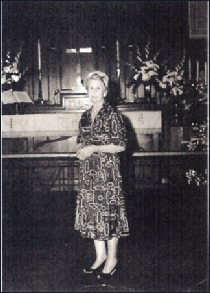
Maternal Grandfather
Rees Reese was born to Amelia Renowden Rees and James David Rees in the village of Rhandirmwyn, County of Carmarthenshire, Wales, in 1874. He was the third child, and the third son, born to the family. He eventually had eight siblings, although four died in childhood. The four remaining were David (born 1871), Daniel (born 1875), Mary (born 1876) and Bessie (born 1883 in America).
The family lived at #4, Pannau Street, a stone row house of eight homes, built especially for the miner’s families. The house had two rooms, one downstairs and one upstairs and was heated in the winter by a fireplace in the living room, using coal. The entire family (nine people at its most) slept together in the single upstairs bedroom.
I don’t know if Rees attended school in Wales although a school had been formed in the village by that time. None of his family appears in the school rosters. I do know that he had eloquent handwriting and could read newspapers at the end of his life.
The family moved to America in 1882, when Rees was eight years old. At that time, the family consisted of seven children, Rees being right in the middle by age. Tragically, the youngest child, Elizabeth who was two years old, burned to death when her nightgown caught fire from a candle, the night before the family sailed from Liverpool.
In America, the family settled in Wilkes-Barre, Pennsylvania, where mining skills were useful and jobs could be found. Within a year, a diphtheria epidemic took two more children: John, age eleven and the next oldest boy to Rees, and Isaac, now four years old, died in 1883. Also in 1883, a new baby girl, Bessie, joined the family, and in 1884 another baby was on the way. Amelia and the baby, Charles, both died in 1884, most likely a result of a difficult childbirth.
At age ten, Rees was left without a mother and grieving the loss of three siblings. In addition, there was a one-year-old baby sister with no mother. It’s not hard to imagine how difficult those years were for this immigrant family.
The oldest child, David, was 13, but by the time he was 18, he had returned to Wales for about ten years where he married and had children. There is a story that James, his father, also returned to Wales about that time but I can’t corroborate it. If so, he returned within a year as he is “missing” from directories during the year 1890. If true, that would mean Rees was the lone head of the family at age 15 or 16 for about a year, with a seven-year old sister, and responsibility for two other siblings.
Rees Reese was born to Amelia Renowden Rees and James David Rees in the village of Rhandirmwyn, County of Carmarthenshire, Wales, in 1874. He was the third child, and the third son, born to the family. He eventually had eight siblings, although four died in childhood. The four remaining were David (born 1871), Daniel (born 1875), Mary (born 1876) and Bessie (born 1883 in America).
The family lived at #4, Pannau Street, a stone row house of eight homes, built especially for the miner’s families. The house had two rooms, one downstairs and one upstairs and was heated in the winter by a fireplace in the living room, using coal. The entire family (nine people at its most) slept together in the single upstairs bedroom.
I don’t know if Rees attended school in Wales although a school had been formed in the village by that time. None of his family appears in the school rosters. I do know that he had eloquent handwriting and could read newspapers at the end of his life.
The family moved to America in 1882, when Rees was eight years old. At that time, the family consisted of seven children, Rees being right in the middle by age. Tragically, the youngest child, Elizabeth who was two years old, burned to death when her nightgown caught fire from a candle, the night before the family sailed from Liverpool.
In America, the family settled in Wilkes-Barre, Pennsylvania, where mining skills were useful and jobs could be found. Within a year, a diphtheria epidemic took two more children: John, age eleven and the next oldest boy to Rees, and Isaac, now four years old, died in 1883. Also in 1883, a new baby girl, Bessie, joined the family, and in 1884 another baby was on the way. Amelia and the baby, Charles, both died in 1884, most likely a result of a difficult childbirth.
At age ten, Rees was left without a mother and grieving the loss of three siblings. In addition, there was a one-year-old baby sister with no mother. It’s not hard to imagine how difficult those years were for this immigrant family.
The oldest child, David, was 13, but by the time he was 18, he had returned to Wales for about ten years where he married and had children. There is a story that James, his father, also returned to Wales about that time but I can’t corroborate it. If so, he returned within a year as he is “missing” from directories during the year 1890. If true, that would mean Rees was the lone head of the family at age 15 or 16 for about a year, with a seven-year old sister, and responsibility for two other siblings.
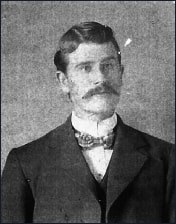
In my grandfather’s eyes, the true hero of the orphaned family was Mary, or “May” as my grandfather lovingly called her. May took over the nurturing of the family after her mother died. She was eight years old when Amelia died and baby Bessie was only one year old. May, being the only other girl, was most probably her “mother” from then on. She never worked outside the home, but always kept house for her father and brothers. Later when Daniel married, his wife died and he was left with three small children. May moved to Detroit and helped him raise those children, too. She never married and never had her own family.
Rees started working by age 18, first as a driver, then a miner for the next 4-6 years, and at age 24, he began working as a surveyor. His father worked all his life as a laborer or a miner, but Rees managed to become a white-collar worker eventually, and left the work as miner behind him.
On June 18, 1902, Rees married Catherine Kemery Moyer in West Pittston, Pennsylvania. I don’t know how they met and what their courtship was like, but all the pictures of Grandpa during those years are smiling with twinkling eyes. I have a small picture of him with handwritten notes on the back: “Nov 12, 1899; July 18, 1900 Pic; Aug 5, 1900 Yes; Feb. 2 1902 Ring”….and on June 18, 1902, they were married. I believe it is a “diary” of the courtship progress.
Soon after the wedding, the couple left for Minnesota to join Catherine’s older brother Will there. They settled in Hibbing and later Virginia, and by 1904, had their first child, William Moyer Reese. Howard David Reese came along in 1907, and in 1912, Catherine Rebecca Reese (my mother) was born.
Rees started working by age 18, first as a driver, then a miner for the next 4-6 years, and at age 24, he began working as a surveyor. His father worked all his life as a laborer or a miner, but Rees managed to become a white-collar worker eventually, and left the work as miner behind him.
On June 18, 1902, Rees married Catherine Kemery Moyer in West Pittston, Pennsylvania. I don’t know how they met and what their courtship was like, but all the pictures of Grandpa during those years are smiling with twinkling eyes. I have a small picture of him with handwritten notes on the back: “Nov 12, 1899; July 18, 1900 Pic; Aug 5, 1900 Yes; Feb. 2 1902 Ring”….and on June 18, 1902, they were married. I believe it is a “diary” of the courtship progress.
Soon after the wedding, the couple left for Minnesota to join Catherine’s older brother Will there. They settled in Hibbing and later Virginia, and by 1904, had their first child, William Moyer Reese. Howard David Reese came along in 1907, and in 1912, Catherine Rebecca Reese (my mother) was born.
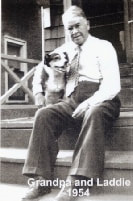
After Grandma Reese died, in 1943, Grandpa lived alone and worked as a civil engineer for the City of Virginia. He traveled to San Diego, to Mexico, and to Florida. He never went back to Wales.
About 1949 to 1954, Grandpa Reese lived with us after he suffered a heart attack. He helped take care of me on school days while my mom was working. His specialty for lunch was fried potatoes. I think it might have been his only culinary skill. In our small three bedroom house, Mom and I shared a bedroom, and Bob and Grandpa each had a room. It was a pretty crowded place.
Grandpa loved to tell stories and after school, I heard things that he had never told anyone else. He told me about the death of his tiny sister, Elizabeth, on the night before they sailed from England to America. She was two, and carried a candle up the stairs of a boarding house in Liverpool, where they spent the last night before sailing. Her nightgown caught fire and she burned to death. The family had to leave the next day on the ship where they had booked passage. It was a sad family secret that he had never told anyone else before, but he, at age 8, had strong memories of it.
Grandpa had a great sense of humor and liked to tease and chuckle about things. He always wore a suit with a vest, and dress shirt, the same clothes he had worn to work as a mine clerk and city employee. He surpassed his family roots and did not have to work as a miner down in the pit, but in an office. He loved Laddie, our old dog. The two old friends sat together many hours on the front steps of the house.
As his health got worse, he went to the Masonic Home in Richfield, Minnesota, to live the last years of his life. In 1954, Bob went off to college in Colorado and Grandpa moved to Minneapolis and the house had only two of us, Mom and me. Grandpa died in 1955, after suffering a stroke. Laddie died the same year.
About 1949 to 1954, Grandpa Reese lived with us after he suffered a heart attack. He helped take care of me on school days while my mom was working. His specialty for lunch was fried potatoes. I think it might have been his only culinary skill. In our small three bedroom house, Mom and I shared a bedroom, and Bob and Grandpa each had a room. It was a pretty crowded place.
Grandpa loved to tell stories and after school, I heard things that he had never told anyone else. He told me about the death of his tiny sister, Elizabeth, on the night before they sailed from England to America. She was two, and carried a candle up the stairs of a boarding house in Liverpool, where they spent the last night before sailing. Her nightgown caught fire and she burned to death. The family had to leave the next day on the ship where they had booked passage. It was a sad family secret that he had never told anyone else before, but he, at age 8, had strong memories of it.
Grandpa had a great sense of humor and liked to tease and chuckle about things. He always wore a suit with a vest, and dress shirt, the same clothes he had worn to work as a mine clerk and city employee. He surpassed his family roots and did not have to work as a miner down in the pit, but in an office. He loved Laddie, our old dog. The two old friends sat together many hours on the front steps of the house.
As his health got worse, he went to the Masonic Home in Richfield, Minnesota, to live the last years of his life. In 1954, Bob went off to college in Colorado and Grandpa moved to Minneapolis and the house had only two of us, Mom and me. Grandpa died in 1955, after suffering a stroke. Laddie died the same year.



